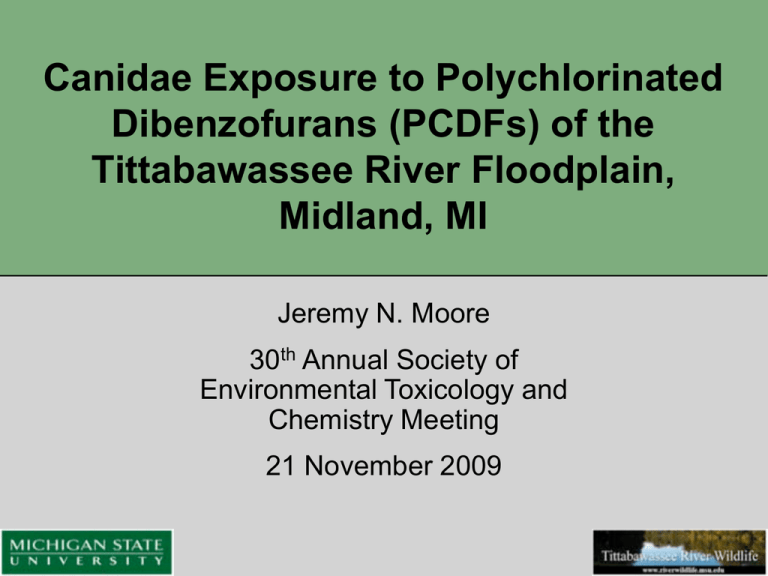Canidae Exposure to Polychlorinated Dibenzofurans (PCDFs) of the Tittabawassee River Floodplain, Midland, MI
advertisement

Canidae Exposure to Polychlorinated Dibenzofurans (PCDFs) of the Tittabawassee River Floodplain, Midland, MI Jeremy N. Moore 30th Annual Society of Environmental Toxicology and Chemistry Meeting 21 November 2009 Coauthors • Michigan State University, East Lansing, Michigan – M. Zwiernik, S. Bursian and S. Fitzgerald • Entrix, Inc., Okemos, Michigan – J. Newsted, M. Shotwell, M.Barker, S. Roark and D. Kay • University of Saskatchewan, Saskatoon, Saskatchewan – J. Giesy and X. Zhang • Texas Tech University, Austin, Texas – S. Plautz Introduction • Tittabawassee River, Midland, MI • Presence of polychlorinated dibenzo-p-dioxins (PCDDs) and polychlorinated dibenzofurans (PCDFs) in river sediment and floodplain soils • Particularly, 2,3,7,8-tetrachlorodibenzofuran (TCDF) and 2,3,4,7,8-pentachlorodibenzofuran (PeCDF) which comprise as much as 90% of the total 2,3,7,8tetrachlorodibenzo-p-dioxin (TCDD) equivalents (TEQs) Tittabawassee River Project • Tittabawassee River Ecological Risk Assessment (ERA), Midland, MI, USA – Multiple line of evidence approach – Michigan State University’s Aquatic Toxicology Laboratory • Receptor species include: great horned owl (Bubo virgianus), great blue heron (Ardea herodias), kingfisher (Ceryle alcyon), tree swallow (Tachycineta bicolor), Eastern bluebird (Sialis sialis), house wren (Troglodytes aedon), American robin (Turdus migratorias) and American mink (Mustela vison) Mammalian Exposure • The greatest dioxin-like exposure expressed as mammalian TEQs is from PeCDF and TCDF – Mink - mean liver sum TEQs = 400 ± 74 ng/kg ww • TEQPeCDF = 56 % Total • TEQTCDF = 7 % Total (Zwiernik et al. 2008) • While much attention has focused on bird species and mink, no work has been done to evaluate the exposure of large long-lived mammals associated with terrestrial food chains in the floodplain Tittabawassee River – Site map Objectives • Determine: – Large terrestrial mammalian predators present within the Tittabawassee River floodplain – Histological abnormalities – Examine a biomarker of exposure – Hepatic TEQ concentrations – Average Daily Dose (ADD) – The species most exposed to PCDFs based on enzyme activity and hepatic mammalian TEQs Resident Floodplain Predators • 3 genera represented within the Canidae family • Coyote (Canis latrans), red fox (Vulpes vulpes) and gray fox (Urocyon cinereoargenteus) Canidae Home Ranges • Coyote – 10 - 40 km2 • Red Fox – 1 - 5 km2 • Gray Fox – 0.13 - 3.1 km2 Field Methods - Time • Canids (11) were trapped and collected during the state regulated trapping season immediately downstream of Midland, Michigan in the fall of 2006 • 3 - coyote (11/3 - 11/10) • 5 - red fox (10/27 - 11/10) • 3 - gray fox (10/19 - 11/10) Field Methods - Trapping Field Methods – Field Sampling • Field lab sampling – Sub-sample of liver collected immediately upon euthanization and placed in liquid nitrogen for subsequent measurement of cytochrome P450 enzymatic activity; ethoxyresorufin O-deethylase (EROD) and methoxyresorufin O-deethylase (MROD) as a biomarker of exposure – Hide removed and carcass frozen at – 20oC until full necropsy Laboratory Necropsy Methods • Animals necropsied at the Michigan State University (MSU) University Research Containment Facility (URCF) • Examined by a board certified pathologist from MSU’s Diagnostic Center for Population and Animal Health (DCPAH) • Morphological measurements, gross observation and tissue collection Analysis Methods • Board certified pathologist examined lungs, heart, liver, lymph nodes, kidneys, bladder and spleen • P450 activity and protein concentration were measured using a Fluoroscan Ascent microplate fluorometer • Liver tissue concentrations determined by EPA extraction method 8290 and High Resolution Mass Spectrometry (HR-MS) • Gastrointestinal contents dried, weighed and sorted Results – Histology and Activity • Histology – No gross or histological abnormalities • Liver EROD and MROD: – Red fox ranged from 71.4 to 221 pmol/mg/min – Coyote ranged from 13.4 to 112 pmol/mg/min – Gray fox ranged from 11.3 to 17.8 pmol/mg/min Hepatic TEQs and Enzyme Activity • Enzyme Activity and Canid Hepatic TEQs Results – % PCDF TEQs in Liver Dietary Percentages (literature-based) Coyote Red Fox Deer 40 None Small mammal 20 24 Shrew1 2 1.5 Rabbit 20 40 Bird 15 14 Invertebrate 2 4 Plant 1 7 Soil2 2.8 2.8 1proportion of shrew is estimated based on relative abundance of shrews to other small mammals in Michigan 2soil ingestion is percent of dry weight of food ingestion; reported by Beyer et al 2004 for red fox Dietary Concentration and Average Daily Dose Estimate Coyote Red Fox 28 (87) 27 (149) Food ingestion rate2 (kg/kg bw/d) 0.023 0.10 Average daily dose3 (ng TEQ/kg bw/d) 0.83 (2.6) 3.6 (17) Dietary concentration1 (ng TEQ/kg ww food) All concentration data displayed as median with 95th centile in parentheses 1based 2red on site-specific data from MSU ERA studies on Tittabawassee River fox ingestion is based on Sargeant 1978; coyote is from Laundre and Hernandez 2003 Conclusions • 3 genera of canids (coyote, red fox and gray fox) are present in the Tittabawassee River floodplain • These canids are exposed to detectable levels of PCDFs including PeCDF, TCDF and 1,2,3,4,7,8 hexachlorodibenzofuran (HxCDF) and can therefore be considered a receptor species of the Tittabawassee River Conclusions • EROD/MROD activity confirms exposure of these dioxin-like compounds • Preliminary findings indicate that: – no morphological or histological abnormalities in 3 species/11 individuals of large mammalian terrestrial predators exposed to hepatic tissue levels of PCDFs ranging from 5.14 to 214 ng sum mammalian TEQ/kg, ww Conclusions • Preliminary findings also indicate that of the canids known to be on-site the red fox appears to be the most highly exposed to dioxin-like compounds – Tissue and dietary exposure assessments agree Further Study and Future • Age of individuals by cementum annuli count to look at variability in exposure • Bioaccumulation Factors (BAFs) • Jaw histology – biomarker potential Other presentations… • Multiple lines of evidence risk assessment for belted kingfisher exposed to PCDD/DF in the Tittabawassee River floodplain, Midland, MI USA • A site-specific, multiple lines of evidence risk assessment of great horned owl (Bubo virginianus) exposure to PCDD/DFs in the Tittabawassee River floodplain in Midland, MI USA • Assessing the exposure and condition of American robins along the Tittabawassee River using a multiple lines of evidence approach • Adult and nestling band returns and long-term survival monitoring of three passerine species inhabiting the Tittabawassee River basin • Concentrations of PCDDs and PCDFs in eggs and diets of wood ducks and hooded mergansers • The Effects of TCDD, PeCDF and TCDF on Development of Maxillary and Mandibular Squamous Epithelial Proliferation in Mink Thank you! Jeremy N. Moore Graduate Student Michigan State University Department of Animal Science moorej42@msu.edu




